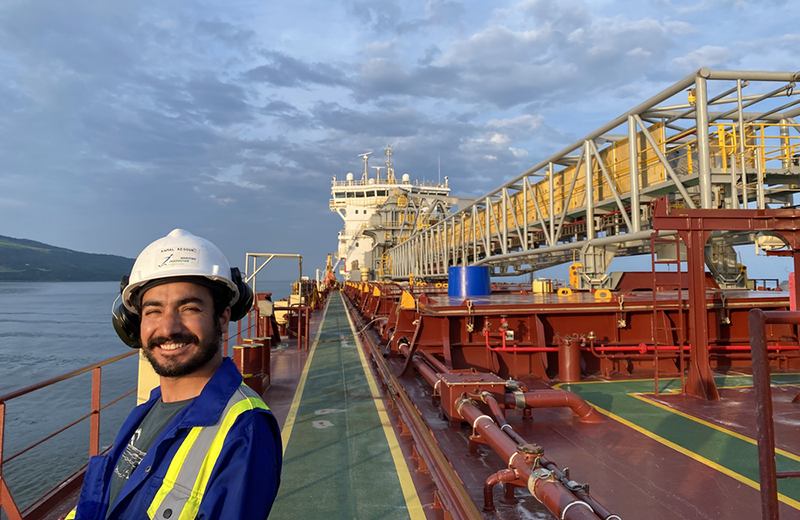Seeking Solutions to Underwater Noise Pollution
From early in his career, Kamal Kesour understood the damaging effects of urban noise and was aware of the instrumentation used to measure and control it. He had lived in big cities, and after his PhD he went to work for an environmental consulting firm that specialized in urban noise. But it wasn’t until later, during a research position at Innovation Maritime in Canada, that he realized marine mammals can experience similarly noisy environments. This noise comes from underwater vibrations generated by shipping vessels transporting goods around the world. Kesour now has a career helping to make maritime transportation vessels less noisy.
Kesour has spent the past few years in Rimouski, Canada, at the Marine Acoustic Research Station (MARS), which lies on the banks of the St. Lawrence Estuary and is jointly led by Innovation Maritime, the Rimouski Institute of Marine Sciences, and engineering consultancy OpDAQ systems. There, he measures ambient underwater noise from ships as they pass on their way to and from the Atlantic Ocean or North America’s Great Lakes. He also conducts on-ship measurements to help pinpoint noise sources and to “fingerprint” the vibrations of individual ships. Physics Magazine caught up with Kesour to learn more about his measurements and their implications for noise pollution produced by the shipping industry.
All interviews are edited for brevity and clarity.
Why is underwater shipping noise a problem?
Sound is key to the survival of marine mammals, which use sound waves to locate food and to interact with one another. Shipping vessels emit noise from their propellers and from engine machinery that can interfere with these day-to-day activities, as they can overpower the sound the animals make. The problem is only getting worse as the number of vessels shipping goods around the world continues to increase.
How do you measure the underwater sounds of a ship?
We use vertical arrays of hydrophones that are tethered to the floor of the St. Lawrence Estuary. The measurement location is near existing shipping lanes with 8000 commercial vessels sailing past the location every year. A diverse lineup of marine mammal species also feed along this part of the estuary each summer.
The MARS project partners with four Canadian shipowners whose vessels sail along the St. Lawrence Estuary. We’ve been able to measure 250 transits of these ships and make onboard measurements as the ships sail. That allows us to connect underwater sounds to their above-water sources. That’s a unique way to address the origins of underwater noise and mitigating its impact on the environment.
How so?
These measurements reveal whether a ship produces noise in a frequency range that is audible to marine mammals and, if so, what object is producing it. That information can then be used to reduce or eliminate sounds with those frequencies. We are currently creating a catalog of underwater noise contributors, linking every sound to a specific ship source. The measurements will also help regulatory bodies determine noise limits for ships.
What are the main noise culprits?
Ship engines chugging, gearboxes grinding, and propellers cavitating—a phenomenon in which pressure changes in the water induced by the rotating propeller lead to the formation of bubbles that immediately implode, sending out audible shock waves.
What’s it like to conduct experiments on a on big ship?
It’s another world. The main engines of these ships can be three floors high. And by living onboard I get to understand how the operations work and what sort of checks and maintenance tasks needs to happen each time the ship leaves dock. I get to discuss my measurements with the crew and to explain what underwater noise is and why it matters. The crews I’ve worked with are now aware of the problem and they want to know how to fix it.
What solutions currently exist to reduce unwanted ship noise?
Right now, the main solution is for a ship to slow down. We know that propeller cavitation only happens once the propeller speed goes beyond a certain value. MARS researchers have been able to identify that value for some ships we’ve worked with, so the crews have a number to pay attention to. More generally, new propeller designs, more regular vessel maintenance, and better hull coatings could also help to reduce noise. We are also working with shipyards and shipowners to optimize conventional solutions and to develop new ones involving, for example, antivibration mounts, acoustic insulation, and resonators that could reduce underwater noise at specific frequencies.
What do you like best about working on this problem?
There are a lot of people who care about improving life for marine mammals and reducing pollution—in all its forms—in the environment. That’s inspiring to me.
–Rachel Berkowitz
Rachel Berkowitz is a Corresponding Editor for Physics Magazine based in Vancouver, Canada.





